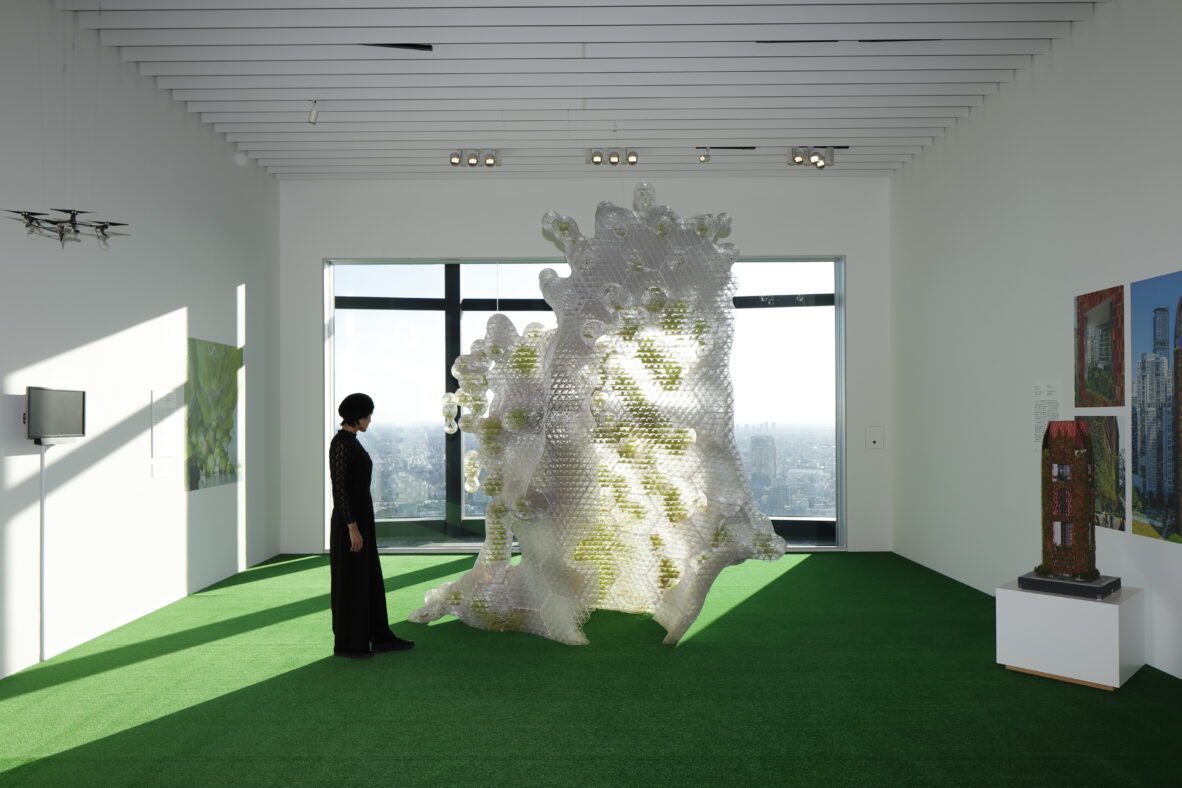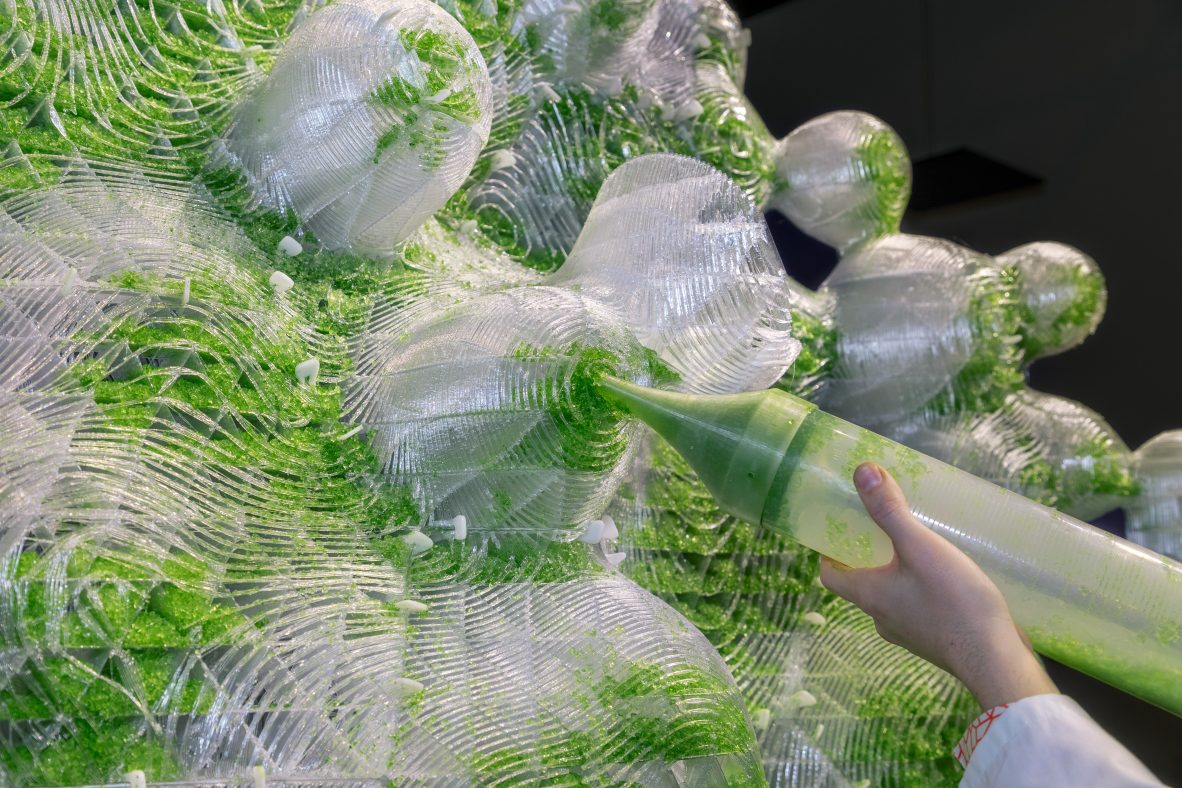“H.O.R.T.U.S. XL. ASTAXANTHIN.G”, CLAUDIA PASQUERO Y MARCO POLETTO (ECOLOGICSTUDIO)(UK)

Title of the artwork: H.O.R.T.U.S. XL Astaxanthin.g
Author: Claudia Pasquero y Marco Poletto (ecoLogicStudio)
Date: 2019
Source:
ARTWORK ABSTRACT
From their innovative architecture and design studio, the authors of this work are focused on finding solutions to the imminent environmental problem we are facing. With pieces such as H.O.R.T.U.S. XL, ecoLogicStudio combines the creative process with fields such as biotechnology or neuroscience to explore the artistic possibilities in the new era, as well as its role in society. Pasquero compares design to morphogenesis, the biological process responsible for the development of the shape of an organ or organism. They seek to combine scientific and technological development with nature, demonstrating that it is possible to make responsible, respectful and beneficial use of both.
Poletto speaks of the need to rethink nature and its presence in cities; planting trees will not solve the worrying levels of CO2 in our atmosphere, however, if we apply a collective intelligence, and not anthropocentric, perhaps we can. To this end, ecoLogicStudio pays more attention to microbiology and its processes, developing projects like this one or like Tech HUT (2017), a biotechnological building with cyanobacteria integrated throughout the structure that take energy waste, transforming heat and CO2 into clean air and new energy.
GET INSPIRED
In the exhibition space we find a sculptural piece that reminds us of a coral form, made of transparent material, with cells occupied by a green substance, its vision raises multiple questions: are we on the surface of the earth or at the bottom of the sea, what does it transmit to me, why all this display, since it has undeniable plastic qualities, is it a work of art, or are we inside a biotechnological laboratory, what is there beyond the pure aesthetic contemplation of the work?
WHAT DOES THIS WORK CONVEY TO US?
What materials / media are used in the work and why?
This work could be considered a sculptural-installationist type or, according to the production process, we could advance a new categorization and speak of a bio-digital sculpture or biosculpture.
In the current digital era, a new interaction is emerging between creation and the fields of life sciences, neuroscience and synthetic biology. The notion of “living” takes on a new form of artificiality, which permeates our entire urban sphere, the global apparatus of contemporary urbanity. Here, the miniaturization, distribution and intelligence of man-made urban networks have reached complexity in the human being, generating evolutionary processes of synthetic life on Earth, a new generation of thick biophilic architectural skins receptive to urban living.
In this case, the authors rely on the morphology of coral by recreating, through an algorithm, the growth of a substrate with that appearance. Technically, 3D printing machines deposit the plastic material in 400 micron layers, supported by 46 mm triangular units and divided into 18.5 cm hexagonal blocks. Photosynthetic cyanobacteria are inoculated in a biogel medium into the individual triangular cells, or bio-pixel, forming the system’s biological intelligence units. Their metabolisms, powered by photosynthesis, convert radiation into actual oxygen and biomass. The density value of each bio-pixel is digitally calculated to optimally arrange the photosynthetic organisms along the iso-surfaces of the incoming radiation enhancement. Among the oldest organisms on Earth, the unique biological intelligence of cyanobacteria is brought together as part of a new form of bio-digital architecture.
Applying biomimetics, in H.O.R.T.U.S. XL the main, printed structure is the result of an algorithm inspired by the collective morphogenesis of coral and the study of biological models of endosymbiosis, a biological interaction in which one organism inhabits the interior of another. Thus, the cells of the structure house a green compound called biogel composed of photosynthetic oxyphotobacteria or cyanobacteria, microorganisms capable of oxygenic photosynthesis. Through this process, this species of algae take the necessary electrons from water and pollution to produce pure oxygen, acting as a natural air purifier, totally sustainable.
Are we talking about the generation of life, the creation of “human gardens”?
What is the significance of the elements of the work?
The work H.O.R.T.U.S.S. XL advances into the future by reconnecting with nature, obtaining from its wisdom the necessary tools to create what they have called a biosculpture. Before it, the imaginary acquired from the classic science fiction filmography pales (Blade runner; The Fifth Element; Avatar; Cocoon; 2001, a space Odyssey, etc.).
Gaudí once said “the architect of the future will be based on the imitation of nature, because it is the most rational, durable and economical of all methods”. The modernist architect announced with this phrase what we know today as biomimicry, a science based on the study of nature as a model and inspiration. Since then, biomimicry has been applied in architecture, where bird’s nests, for example, have helped to combine flexibility, lightness and resistance in earthquake-prone areas, to something as everyday as Velcro, a simple adaptation of the borriquero thistle.
In this piece there is a sort of imitation of nature through the appearance in the exhibition space of a marine form, decontextualized, out of its habitat, endowed with what we guess as an unsuspected transforming power of the environment, despite its generation based on plastic materials. Thanks to it, by applying biotechnology and broadening our horizons, it is possible to imagine a sustainable future, respectful of our planet, where technology and nature are mutually beneficial. H.O.R.T.U.S.XL not only exemplifies this possibility, it is also a way to draw attention to this issue, being a piece that serves to raise awareness and educate about this problem and the need to think of new solutions.
About the artist
Claudia Pasquero y Marco Poletto, authors and founders of ecoLogicStudio (Londres, 2005) www.ecologicstudio.com. Research partners: Urban Morphogenesis Lab en The Bartlett UCL, Synthetic Landscape Lab en Innsbruck University y Wasp Hub en la University of Southern Denmark.
Author of the analysis: Carmen Salazar Pera

![overlaps [Converted]3](https://aster.us.es/wp-content/uploads/2022/06/HORTUSXL_POMPIDOU_threshold-overlaps_inv_rs3t-1222x1013-1.jpg)